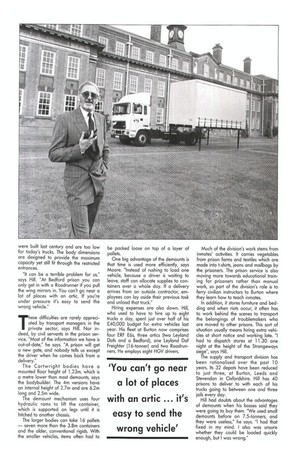More work for less trucks The Government's prison deliveries service
Page 56

Page 57

If you've noticed an error in this article please click here to report it so we can fix it.
is now coping with more work using fewer trucks thanks to the introduction of demounts to the fleet.
Switching from conventional rigids to demounts has enabled the Government's prison deliveries service to cope with 25% more work with 25% fewer trucks. The demounts allow a quicker turnaround at depots, and as they are fitted to low-chassis ERFs, they can carry almost twice as much as the old rigids.
The Home Office's supply and transport division, whose duties include storing and delivering textiles, work materials and furniture to jails, begun taking on the vehicles in late 1988. It is now running 40 demounts on 15 ERF E6s.
The demounts enable drivers to pick up a loaded body from stores first thing in the morning. Staff can then fill another container during the day, and even if the driver returns after the depot closes, the other body is ready for him to drive away early the next morning.
Geiting on the road early is crucial, as prison gates often close at 11 am for security reasons. Even if a driver arrives minutes after that, he has to wait until after 2pm before they open again. Before taking on the demounts, the stores bosses had the choice of having drivers hanging around during the morning, while their vehicles were loaded, or running spare trucks.
"In the old days, we lost a driver for half a day if we didn't have another vehicle available," says Gordon Hill, transport manager at Burton, one of the division's three depots. Some drivers had to have two trucks, so that one would always be ready, loaded in the morning.
The reduction in fleet has been gradual, says technical services manger Michael Moore. The division has taken on a wider range of trucks, which now includes artics. The demount bodies are designed to be carried in twos on an articulated semi-trailer for trunking.
Altrincham-based bodybuilder Cartwright has supplied 28 of the demounts. The rest are made by Keyway of Wolverhampton. Almost all of them are curtainsiders, although two solid-side, lockable containers are used for deliveries where security has to be extra tight.
The bodies come in two sizes — 4m and 3.8m high. The overall size of the vehicle is vital, as many prison gates were built last century and are too low for today's trucks. The body dimensions are designed to provide the maximum capacity yet still fit through the restricted entrances.
"It can be a terrible problem for us," says Hill. "At Bedford prison you can only get in with a Roadrunner if you pull the wing mirrors in. You can't go near a lot of places with an artic. If you're under pressure it's easy to send the wrong vehicle." These difficulties are rarely appreciated by transport managers in the private sector, says Hill. Nor indeed, by civil servants in the prison service. "Most of the information we have is out-of-date," he says. "A prison will get a new gate, and nobody tells us except the driver when he comes back from a delivery."
The Cartwright bodies have a mounted floor height of 1.23m, which is a metre lower than most demounts, says the bodybuilder. The 4m versions have an internal height of 2.7m and are 6.2m long and 2.5m wide.
The demount mechanism uses four hydraulic rams to lift the container, which is supported on legs until it is hitched to another chassis.
The larger bodies can take 16 pallets — seven more than the 3,8m containers and the older, conventional rigids. With the smaller vehicles, items often had to be packed loose on top of a layer of pallets.
One big advantage of the demounts is that time is used more efficiently, says Moore. "Instead of rushing to load one vehicle, because a driver is waiting to leave, staff can allocate supplies to containers over a whole day. If a delivery arrives from an outside contractor, employees can lay aside their previous task and unload that truck."
Hiring expenses are also down. Hill, who used to have to hire up to eight trucks a day, spent just over half of his £40,000 budget for extra vehicles last year. His fleet at Burton now comprises four ERF E6s, three artics (two Leyland Dafs and a Bedford), one Leyland Daf Freighter (1 6-tanner)and two Roadrunners. He employs eight HGV drivers. Much of the division's work stems from inmates' activities. It carries vegetables from prison farms and textiles which are made into t-shirts, jeans and mailbags by the prisoners. The prison service is also moving more towards educational training for prisoners rather than manual work, so part of the division's role is to ferry civilian instructors to Burton where they learn how to teach inmates.
In addition, it stores furniture and bedding and when riots occur, it often has to work behind the scenes to transport the belongings of troublemakers who are moved to other prisons. This sort of situation usually means hiring extra vehicles at short notice and working late. "I had to dispatch stores at 11.30 one night at the height of the Strangeways siege", says Hill.
The supply and transport division has been rationalised over the past 10 years. Its 32 depots have been reduced to just three, at Burton, Leeds and Stevendon in Oxfordshire. Hill has 40 prisons to deliver to with each of his trucks going to between one and three jails every day.
Hill had doubts about the advantages of demounts when his bosses said they were going to buy them. 'We used small demounts before on 7,5-tonners, and they were useless," he says. "I had that fixed in my mind. I also was unsure whether they could be loaded quickly enough, but I was wrong."




































































































